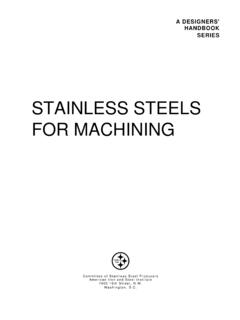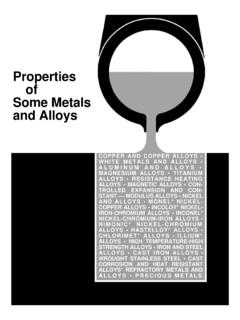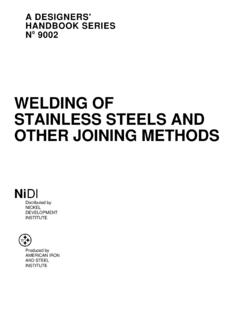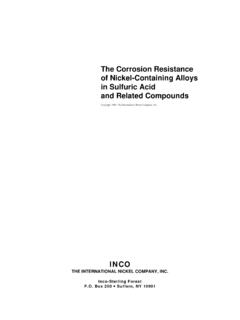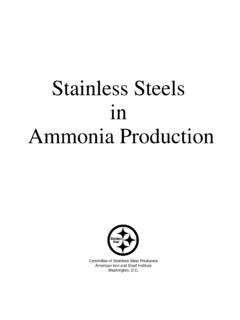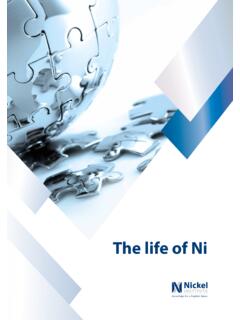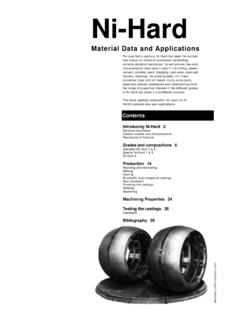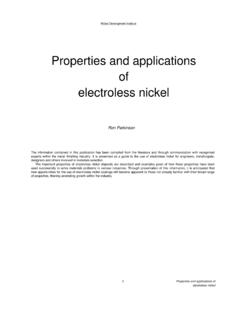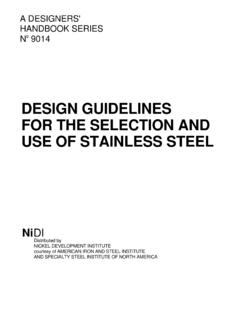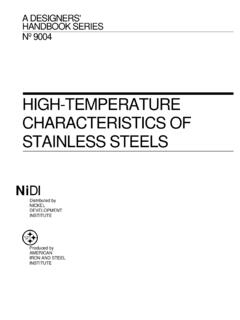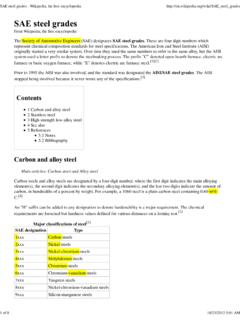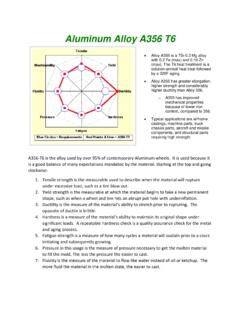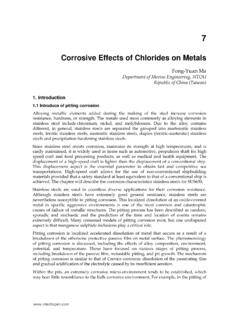Transcription of Guidelines for - Nickel Institute
1 Guidelines forthe welded fabricationof Nickel alloys for corrosion-resistant service A PRACTICAL GUIDE FOR WELDERS, MATERIAL ENGINEERS AND DESIGN ENGINEERSKNOWLEDGEFOR A BRIGHTERFUTURE2 Guidelines for the welded fabrication of Nickel alloys for corrosion-resistant service2 Guidelines for the welded fabrication of Nickel alloys for corrosion-resistant serviceA PRACTICAL GUIDES econd Edition Published 2018 The material presented in this publication has been prepared for the general information of the reader and should not be used or relied on for specific applications without first securing competent Nickel Institute , its members, staff and consultants do not represent or warrant its suitability for any general or specific use and assume no liability or responsibility of any kind in connection with the information report was prepared by:Richard E. AveryConsultant to the Nickel Editor: Geir Moe3 ContentsContentsIntroduction ..7 PART I For the welder.
2 9 Physical properties of Nickel alloys ..9 Corrosion resistance of Nickel alloy welds ..9 Welding qualifications ..11 Welding procedure specification ..11 Welder performance qualification and training ..12 Weld joint design ..12 Preparation for welding ..13 Welding processes ..17 Shielded metal arc welding (SMAW) ..17 Gas tungsten arc welding (GTAW) ..19 Gas metal arc welding (GMAW) ..22 Flux cored arc welding (FCAW) ..23 Submerged arc welding (SAW) ..23 Other welding processes ..24 Welding Nickel alloy pipe ..24 Post-fabrication cleaning ..27 PART II For the materials engineer ..29 General Guidelines for Nickel alloys ..29 Group I - Nickel and Nickel -copper alloys ..30 Group II - Chromium-bearing alloys ..31 Group III - Nickel -molybdenum alloys ..31 Group IV - Precipitation-hardening Nickel alloys ..32 Dissimilar-metal welds ..32 Procurement Guidelines ..33 Nickel alloy castings.
3 33 Source Inspections ..35 radiographic inspection; liquid penetrant inspection; weldability test; pressure test; certification; heat treatment; chemistry Casting repair by welding ..37 Welding Nickel alloy castings ..37 Procurement checklist for Nickel alloy castings ..38 PART III For the design engineer ..39 Design for corrosion service ..39 Weld overlay, sheet lining, and clad plate ..43 Weld overlay ..44 SAW; GMAW; SMAW; Weld overlay Guidelines Sheet lining ..45 Clad plate ..45 Safety and welding fumes ..49 Reference documents ..514 Guidelines for the welded fabrication of Nickel alloys for corrosion-resistant serviceTablesTable 1 Wrought Nickel alloys by group ..9 Table 2 Influence of physical properties on welding Nickel alloys ..10 Table 3 Nickel alloy cutting methods ..14 Table 4 Embrittling elements ..14 Table 5 Matching composition filler metals for Nickel alloys .
4 18 Table 6 Comparison of GMAW arc modes for Nickel alloys ..23 Table 7 Nominal composition of significant elements of Groups I IV wrought Nickel and Nickel alloys ..30 Table 8 Nominal composition of cast corrosion resistant Nickel alloys ..31 Table 9 Matching filler metals of the comparable solid solution alloys ..32 Table 10-A Filler metal alloy identification for bare and covered electrodes ..33 Table 10-B Suggested filler metals for dissimilar metal welds ..34 Table 11 Specifications for procurement of wrought Nickel and Nickel alloys ..35 Table 12 Comparisons of weld overlay, sheet lining, and clad plate ..445 ContentsFiguresFigure 1 Incomplete fusion in pipe root pass weld ..10 Figure 2-1 Typical joint designs for to 2-5 sheet and plate ..12,13 Figure 3 Sample showing sulphur embrittlement of a Nickel 200 sheet ..15 Figure 4 Typical backing bar designs for use with and without a backing gas ..16 Figure 5 Tack weld sequence to provide uniform weld gap.
5 17 Figure 6 The arc zone in the SMAW process ..17 Figure 7 The Gas Tungsten Arc Weld (GTAW) process ..20 Figure 8 The basic components of the Gas Metal Arc Weld (GMAW) process ..22 Figure 9 Typical joint design for pipe with consumable insert ..25 Figure 10 Typical joint design for pipe welded with open root joint and hand-fed filler metal ..25 Figure 11 Standard consumable insert shapes, ANSI/AWS D10 .11 ..26 Figure 12 Typical pipe purging fixtures ..26 Figure 13 Flat bottom, square corners worst ..39 Figure 14 Flat bottom, rounded corners good corners poor outside ..39 Figure 15 Flat bottom, rounded corners, grouted good inside, poor outside ..39 Figure 16 Flat bottom, rounded corners, drip skirt good inside, good outside ..39 Figure 17 Concave bottom rounded corners good inside, good outside, fatigue resistant ..39 Figure 18 Dished head best inside, best outside, fatigue resistant ..39 Figure 19 Side outlet above bottom poor.
6 40 Figure 20 Centre outlet, above bottom poor ..40 Figure 21 Side outlet, flush good ..40 Figure 22 Centre outlet recessed good ..40 Figure 23 Side outlet, flush, sloped best ..40 Figure 24 Centre outlet, recessed, sloped best ..40 Figure 25 Corner weld from inside poor inside, worst outside ..40 Figure 26 Corner weld from both sides poor inside, good outside ..40 Figure 27 Side wall in lieu of corner weld best inside, good outside, fatigue resistant ..40 Figure 28 Tray support, staggered strength weld severe crevice ..41 Figure 29 Tray support, full seal weld top good crevice resistance ..41 Figure 30 Tray support, full seal weld top & bottom best crevice resistance ..41 Figure 31 Reinforcing pad, staggered welds adequate strength ..41 Figure 32 Reinforcing pad, seal weld best crevice resistance ..41 Figure 33 Position of angles ..41 Figure 34 Position of angles ..41 Figure 35 Position of channels.
7 41 Figure 36 Stiffeners and baffles ..42 Figure 37 Corner baffle cut-out good ..42 Figure 38 Heat exchanger, baffle cut-out good ..42 Figure 39 Poor and good designs for the location of heaters in a vessel ..42 Figure 40 Poor and good designs for mixing concentrated and dilute solutions ..42 Figure 41 Pipe weld with incomplete penetration severe crevice ..43 Figure 42 Pipe recessed, flange and pipe, same alloy good ..43 Figure 43 Pipe flush, pipe and flange same alloy better ..43 Figure 44 Stub end, flange carbon steel or ductile iron very good ..43 Figure 45 (A) Horizontal (standard) poor ..43 (B) Sloped) very good ..43 Figure 46 Weld joints for liners ..46 Figure 47 Joint designs for clad steel ..466 Guidelines for the welded fabrication of Nickel alloys for corrosion-resistant service7 IntroductionThis publication is presented in three parts with each, in turn, focused toward the primary interests of the welder, the materials engineer, and the design I, FOR THE WELDER, assumes that the welders and others involved in welded fabrication are familiar with the basic techniques used in carbon steel fabrication and have had limited experience with Nickel alloys .
8 The discussion treats many areas of concern to the welder and gives practical suggestions concerning the effects of shop practices in maintaining the corrosion resisting properties of the Nickel alloys . The importance of proper storage and protection of the surfaces, proper cleaning combined with the proper cleaning materials is stressed both before and after welding. Welding and welding training and qualification are discussed as well as arc management during the welding process. A number of commonly used welding processes are covered to furnish a perspective of the particular features that ensure improved results. Finally, the particular considerations involved in welding pipe are discussed. Part I takes a how to approach useful to the non-engineer but the material covered is also a good reference for the materials and design II, FOR THE MATERIALS ENGINEER, describes the types of Nickel alloys ; it reviews how their metallurgical and corrosion characteristics are affected by welding and covers some of the more specialised aspects of fabrication such as heat treating.
9 A number of useful references are included to assist in the selection of electrodes, rods, and filler metals for solid solution alloys . Additional tables cover the selection of electrodes and rods for dissimilar metal welds. Guidelines are included for material procurement of castings along with suggestions for supplementing the specifications with additional requirements and tests to assure the quality of the finished III, FOR THE DESIGN ENGINEER, provides a number of design examples showing how the corrosion performance of Nickel alloys used in process tanks can be enhanced through thoughtful design. A generous number of figures illustrate the configurations which improve the prospects for successful performance in corrosive environments. The discussion also treats weld overlay, sheet lining, and clad plate as alternative means of providing corrosion protection using Nickel alloys . A number of welding processes are briefly evaluated as tools for achieving the desired results with each of these for the welded fabrication of Nickel alloys for corrosion-resistant service9 Part I.
10 For the welderPart I focuses on the fabrication and welding of Nickel alloys as they relate to the welders and production personnel engaged in fabrication of Nickel alloys for corrosion service. Table 1 shows the wrought and cast Nickel alloys by properties of Nickel alloysThe physical properties of solid solution Nickel alloys , Groups I, II, and III, are quite similar to the 300 Series austenitic stainless steels. The solid solution Nickel alloys cannot be strengthened by heat treatment, only by cold working. Group IV alloys , the precipitation hardening Nickel alloys , are strengthened by special heat treatments similar to those for the precipitation hardening (PH) stainless steels. While the solid solution alloys , Groups I, II, and III are predominately used for corrosion-resistant services, the Group IV alloys are used where higher strength is needed, although with usually some small sacrifice of corrosion resistance. Some physical properties and their influence on welding are shown in Table resistance of Nickel alloy weldsThe performance of Nickel alloy equipment in corrosive service is subject to the care taken by welders and others on the shop floor.
